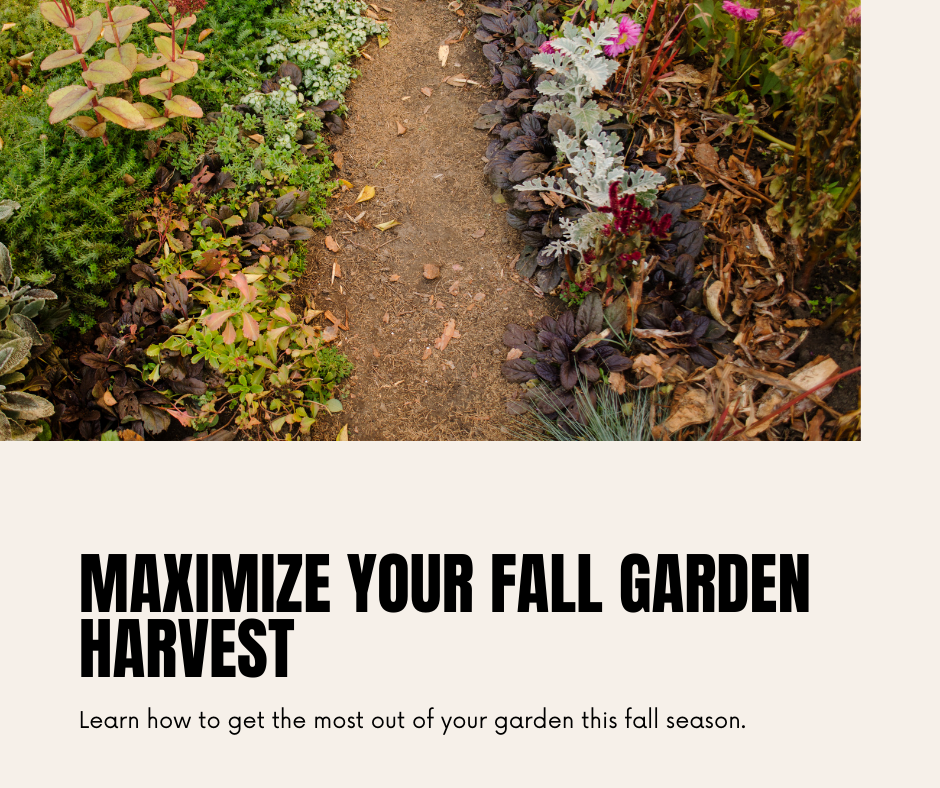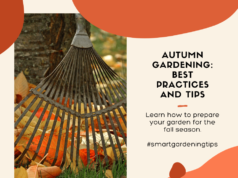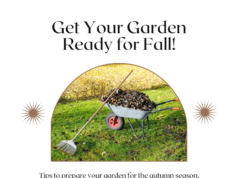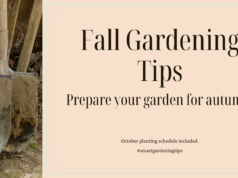
Are you ready to enjoy a bountiful autumn garden? Fall is the perfect time to plan and prepare for a successful harvest. By carefully selecting the right crops, timing your planting, and implementing proper soil and pest management techniques, you can maximize your yield and savor the flavors of the season. In this article, we will explore key tips and strategies to help you make the most of your fall garden harvest.
When planning your fall garden harvest, consider the specific crops you want to grow. Some vegetables thrive in the cooler temperatures and shorter days of autumn, while others may not fare as well. Selecting the right crops is crucial for a bountiful harvest. We will provide insights on the best crops to grow during the autumn season and offer tips for choosing the most suitable varieties for your garden.
Timing is everything when it comes to a successful fall harvest. Knowing when to plant your crops is essential to ensure optimal growth and produce yield. We will guide you through the ideal planting dates for different crops and share guidelines for extending the growing season to maximize your autumn harvest.
Healthy soil is the key to a thriving garden. Soil preparation and maintenance are crucial steps in ensuring the health and productivity of your fall crops. We will discuss the importance of soil testing, amending the soil for optimal growth, and maintaining soil moisture and fertility throughout the fall season.
Pests and diseases can pose significant threats to your fall garden. We will help you identify common pests and diseases that affect autumn crops and provide organic pest control methods to keep your harvest healthy and pest-free.
Harvesting your crops at the peak of ripeness and storing them properly can make a significant difference in their quality and taste. We will share tips and techniques for harvesting autumn crops and guide you on proper storage methods to preserve the freshness and flavor of your harvest.
To extend the growing season and maximize your fall garden harvest, we will explore season extension strategies. From utilizing row covers and cold frames to protecting your garden from early frosts and temperature fluctuations, we will provide practical insights for ensuring your crops thrive until the last days of autumn.
Key Takeaways:
- Select the right crops for a bountiful autumn garden
- Time your planting for a successful fall harvest
- Prepare and maintain healthy soil for optimal growth
- Manage pests and diseases organically for a healthy harvest
- Harvest and store your crops properly to preserve their quality
Selecting the Right Crops for a Bountiful Autumn Garden
Choosing the right crops is essential for a successful fall garden harvest. As the summer heat gives way to cooler temperatures, it’s important to select varieties that thrive in the autumn conditions. Here’s a guide to help you make the best choices for your bountiful autumn garden:
1. Cold-Weather Vegetables
If you live in a region with frosty winters, cold-weather vegetables are your go-to option for the fall garden. These hardy crops can withstand cool temperatures and even improve in flavor with a touch of frost. Some popular choices include:
- Brussels sprouts
- Kale
- Carrots
- Radishes
- Broccoli
- Turnips
Plant these vegetables in late summer or early fall to give them ample time to mature before the first frost hits.
2. Quick-Growing Greens
For a fast and abundant autumn harvest, consider planting quick-growing greens. These leafy vegetables thrive in cool weather and can be ready for harvest in as little as 30 days. Ideal choices for a fall garden include:
- Spinach
- Lettuce
- Arugula
- Swiss chard
These greens can be sown directly into the soil or transplanted from seedlings. With regular watering and some shade from the hot sun, they’ll flourish in your garden.
3. Root Vegetables
Root vegetables are excellent choices for autumn gardens because they can withstand lower temperatures and continue to grow as the season progresses. These below-ground crops store well and offer a range of flavors and textures. Consider planting:
- Beets
- Parsnips
- Turnips
- Carrots
- Onions
Root vegetables thrive in well-drained soil and prefer full sun. Harvest them when they reach their peak size and flavor.
4. Late-Season Herbs
Don’t forget to include herbs in your fall garden. While some herbs might start to die back as the temperatures drop, others can flourish well into autumn. Consider planting:
- Parsley
- Cilantro
- Chives
- Sage
- Thyme
These herbs add fresh flavors to your meals and can be dried or frozen for future use.
Did You Know? Some vegetables, like kale and Brussels sprouts, actually taste sweeter and develop a milder flavor after exposure to frost.
Remember to adjust your garden plan based on your climate zone and frost dates. Experimenting with different crops each year is a fun way to explore the possibilities of your autumn garden.
| Crop | Planting Time | Days to Harvest | Harvesting Tips |
|---|---|---|---|
| Brussels Sprouts | Mid to late summer | 90-100 days | Pick when the sprouts are firm and tight. |
| Kale | Early to mid-summer | 50-70 days | Harvest individual leaves as needed or cut the whole head when mature. |
| Carrots | Late summer to early fall | 60-80 days | Loosen the soil around the roots and gently pull them out. |
| Spinach | Mid to late summer | 35-45 days | Pick outer leaves or harvest the whole plant when it reaches desired size. |
| Beets | Midsummer | 55-70 days | Harvest when the roots reach desired size, usually around 1-3 inches in diameter. |
Remember to provide your crops with consistent water, regular feeding, and protection from pests to ensure a successful autumn garden harvest.
Timing Your Planting for a Successful Fall Harvest
Proper timing is crucial for a productive fall garden. By carefully timing your planting, you can ensure that your crops have enough time to grow and mature before the frost sets in. In this section, we will discuss the ideal planting dates for different crops and provide guidelines for extending the growing season to maximize your autumn harvest.
Planting Dates for Different Crops
Each crop has its own specific planting dates that allow it to thrive in the fall season. Here are some common crops and their recommended planting periods:
- Lettuce: Plant lettuce seeds about 8 weeks before your first expected frost date. This will give them enough time to grow and you can start harvesting the leaves when they are around 3-4 inches tall.
- Carrots: Carrots can tolerate cooler temperatures, making them an excellent choice for fall. Sow carrot seeds about 10-12 weeks before the first expected frost for a sweet and crunchy harvest.
- Broccoli: Start broccoli seeds indoors about 6-8 weeks before your first expected frost date. Transplant them into the garden when they have a few sets of leaves and space them about 18-24 inches apart.
Extending the Growing Season
If you want to extend your fall growing season and enjoy fresh vegetables for longer, there are several techniques you can try:
- Cold Frames: Build or purchase a cold frame to protect your plants from chilly temperatures and frost. A cold frame is like a miniature greenhouse that traps heat and provides a sheltered environment for your crops.
- Row Covers: Covering your plants with row covers can help protect them from frost and also provide some insulation. Row covers are lightweight fabrics that allow sunlight and water to pass through while creating a barrier against cold temperatures.
- Mulching: Applying a layer of mulch around your plants can help regulate soil temperature and moisture levels. Mulch acts as a natural insulator, keeping the soil warm during cool nights and preventing rapid moisture evaporation.
By utilizing these techniques, you can prolong the growing season and harvest fresh produce well into the fall months. Remember to consult your local agricultural extension office or gardening resources for more specific guidance based on your region’s climate and growing conditions.
With proper timing and creative strategies, you can make the most of your fall garden and enjoy a bountiful harvest. In the next section, we will explore soil preparation and maintenance techniques to ensure your plants have the best growing conditions.
Soil Preparation and Maintenance
Healthy soil is the foundation for a thriving garden. To ensure optimal growth and a bountiful fall harvest, it is important to focus on soil testing and amending, as well as maintaining soil moisture and fertility during the fall season.
Soil testing is a crucial step in understanding the composition of your soil and identifying any deficiencies or imbalances. By analyzing the nutrient levels and pH of your soil, you can determine the necessary amendments to provide the ideal growing conditions for your plants. Consider taking a sample of your soil to a local extension office or using a mail-in soil testing kit for accurate results.
Once you have the results of your soil test, you can begin amending your soil to promote optimal growth. Depending on the specific needs of your soil, you may need to add organic matter, such as compost or well-rotted manure, to enrich the soil and improve its texture. Additionally, you may need to adjust the pH level by adding lime to raise it or sulfur to lower it. Follow the recommendations provided by your soil test results and amend your soil accordingly.
To maintain soil moisture and fertility during the fall season, it is important to practice proper watering and mulching techniques. Watering deeply and infrequently, rather than shallowly and frequently, encourages deep root growth and helps plants withstand periods of drought. Applying a layer of organic mulch around your plants helps retain moisture, regulate soil temperature, and suppress weeds. Consider using materials such as straw, shredded leaves, or wood chips as mulch.
“Good soil is the key to a successful garden. Take the time to understand your soil composition and make the necessary amendments for optimal plant growth and health. By maintaining soil moisture and fertility during the fall season, you can ensure a productive and thriving garden.”
Benefits of Soil Testing and Amending:
- Identify nutrient deficiencies and imbalances
- Create optimal growing conditions for plants
- Improve soil structure and texture
- Enhance nutrient availability
Tips for Maintaining Soil Moisture and Fertility:
- Water deeply and infrequently to promote deep root growth
- Apply a layer of organic mulch to retain moisture and regulate soil temperature
- Consider using drip irrigation systems for efficient watering
- Practice crop rotation to prevent nutrient depletion
By prioritizing soil testing and amending, as well as maintaining soil moisture and fertility during the fall season, you can set the stage for a successful and abundant autumn harvest.
Pest and Disease Management
Pests and diseases can pose a significant threat to your fall garden harvest. Identifying and addressing these issues promptly is essential for maintaining the health of your plants and maximizing your yield. In this section, we will explore common fall garden pests and diseases and provide organic pest control methods to ensure a healthy and bountiful harvest.
Identifying Common Fall Garden Pests
It is essential to familiarize yourself with the pests that commonly affect fall gardens. By recognizing the signs of infestation early on, you can take appropriate action to prevent further damage.
- Flea beetles: These tiny, jumping beetles can cause extensive damage to leafy greens and other crops. Look for small holes in the leaves and jumping insects when disturbed.
- Cabbage worms: These green caterpillars feed on leafy greens such as kale, cabbage, and broccoli. Check for chewed leaves and droppings on the plants.
- Aphids: Aphids are small, soft-bodied insects that suck sap from plants, causing stunted growth and distorted leaves. Look for clusters of aphids on the leaves and stems.
Common Fall Garden Diseases
In addition to pests, various diseases can affect your fall garden. Being able to identify these diseases will help you take appropriate measures to prevent their spread.
- Powdery mildew: Powdery mildew appears as a white, powdery coating on the leaves, stems, and fruit. It can cause reduced growth and premature fruit drop.
- Leaf spot: Leaf spot diseases cause small, dark spots on the leaves, which can merge and result in foliage death. Look for discolored and spotted leaves.
- Root rot: This fungal disease affects the roots of plants, causing them to rot and decay. Look for wilting, yellowing leaves and stunted growth.
Implementing Organic Pest Control Methods
When it comes to managing pests and diseases in your fall garden, it is important to prioritize organic and eco-friendly methods. These methods help preserve the health of your plants, the environment, and beneficial insects.
“Implementing organic pest control methods not only protects your crops but also promotes the overall well-being of your garden ecosystem.”
Here are some effective organic pest control methods to consider:
- Handpicking: Removing pests by hand, such as picking off cabbage worms or aphids, can be an effective way to control infestations in smaller gardens.
- Companion planting: Companion plants can help repel pests and attract beneficial insects. For example, planting marigolds near vegetables can deter pests like aphids.
- Biological controls: Introducing beneficial insects, such as ladybugs or predatory nematodes, can help naturally control pest populations. These insects feed on pests and help maintain a balanced ecosystem.
- Organic sprays: Homemade sprays using ingredients like garlic, neem oil, or insecticidal soap can be used to control pests. These sprays are safe for the environment and can be effective against a range of insect pests.
By proactively identifying common fall garden pests and diseases and implementing organic pest control methods, you can maintain the health and productivity of your garden. Now that we’ve covered pest and disease management, let’s move on to the next section, where we’ll explore harvesting and storage techniques for your fall harvest.
Harvesting and Storage Techniques
Harvesting your crops at the right time is essential to ensure they are at the peak of ripeness and flavor. Here are some tips for harvesting your autumn crops:
- Observe the signs: Look for visual cues such as color changes, firmness, and size to determine when your crops are ready for harvest.
- Timing is key: Harvest in the early morning or late evening when the temperatures are cooler. This helps to preserve the flavor and nutritional content of your crops.
- Use the right tools: Use sharp pruning shears or scissors to avoid damaging the plants and ensure a clean, precise cut.
“Harvest when the fruits are fully colored, but before they become overripe.”
Once you’ve harvested your crops, it’s important to store them properly to maintain their quality. Here are some storage methods to preserve the freshness of your harvest:
- Remove excess moisture: Properly dry your harvested crops to prevent the growth of mold and extend their shelf life.
- Store in cool, dark places: Keep your crops in a well-ventilated area away from direct sunlight and heat sources to prevent spoilage.
- Use appropriate packaging: Store your crops in breathable containers or bags that allow for airflow, reducing the risk of moisture buildup.
Proper Storage Times for Some Common Autumn Crops
| Crop | Storage Time |
|---|---|
| Pumpkins | 2-3 months |
| Apples | 2-4 months |
| Potatoes | 4-6 months |
| Winter squash | 3-6 months |
By following these tips for harvesting and storage, you can ensure that your autumn crops are enjoyed at their peak of freshness and flavor throughout the season.
Season Extension Strategies
Extending the growing season is essential for maximizing your fall garden harvest. By utilizing row covers and cold frames, you can protect your plants from early frosts and temperature fluctuations, and extend their growing period for a bountiful autumn garden.
Utilizing Row Covers
Row covers are lightweight, translucent fabrics that can be draped over garden beds to create a protective barrier. They help regulate temperature, retain heat, and prevent frost damage. Row covers also act as a shield against pests, while allowing sunlight and rain to reach the plants.
To use row covers effectively:
- Cover your plants before the first frost is expected to ensure their protection.
- Secure the edges of the row covers to prevent them from blowing away.
- Regularly check the covers for any signs of damage or pests and make necessary adjustments.
Cold Frames for Season Extension
Cold frames are enclosed structures with transparent tops that capture sunlight to create a mini greenhouse effect. They provide warmth and protection against cold temperatures, allowing you to grow plants that are more sensitive to frost.
Here are some tips for using cold frames effectively:
- Position your cold frames in a sunny location, preferably facing south, to maximize exposure to sunlight.
- Ensure adequate ventilation by propping open the lid on warm days or installing vents.
- Monitor temperature and moisture levels inside the cold frame to prevent overheating or excessive drying.
Protecting Your Fall Garden
“Extending the growing season with row covers and cold frames safeguards your fall garden and boosts your harvest potential.”
Protecting your fall garden from early frosts and temperature fluctuations is crucial for maintaining plant health and crop productivity. By utilizing row covers and cold frames, you can create a favorable microclimate that helps your plants thrive despite changing weather conditions. This ensures a continuous harvest of fresh produce throughout the autumn months.
FAQ
Q. How do I plan my fall garden harvest?
A. To plan your fall garden harvest, start by selecting the right crops for the autumn season. Consider factors such as your location, average frost dates, and the length of your growing season. This will help you determine which crops will thrive during the fall. Additionally, make a planting schedule to ensure a staggered harvest and maximize your yield.
Q. Which crops are best for a bountiful autumn garden?
A. Some great crops for a bountiful fall garden include leafy greens like kale, spinach, and arugula, root vegetables such as carrots and radishes, and cool-season crops like broccoli, cauliflower, and Brussels sprouts. These plants are well-suited for the cooler temperatures and shorter daylight hours of the fall season.
Q. When should I plant my fall crops?
A. The ideal planting dates for fall crops can vary depending on your location and the specific crops you are growing. Generally, you should start planting cool-season crops 6-8 weeks before the first expected frost date. For a staggered harvest, you can also make successive plantings every 2-3 weeks. However, be sure to check the recommended planting guidelines for your specific crops for more accurate timing.
Q. How do I amend my soil for optimal growth?
A. Before planting, it’s essential to test your soil to understand its nutrient levels. You can do this by using a soil testing kit or by sending a sample to a local agricultural extension office. Based on the results, you can amend your soil with organic matter, such as compost or well-rotted manure, to improve its fertility and structure. This will provide your plants with the necessary nutrients for optimal growth.
Q. How can I maintain soil moisture during the fall season?
A. To maintain soil moisture during the fall, be sure to water your garden regularly, especially during dry periods. Use a drip irrigation system or soaker hoses to provide a deep watering that reaches the plant roots. Applying a layer of organic mulch around your plants can also help retain moisture in the soil and regulate temperature fluctuations.
Q. What are some common fall garden pests and diseases?
A. Common fall garden pests include aphids, cabbage worms, and slugs. Diseases such as powdery mildew and fungal infections can also affect your plants in autumn. It’s important to monitor your garden regularly and identify any signs of pest infestations or disease. Early detection can help you implement organic pest control methods, such as handpicking pests or using insecticidal soaps, and prevent disease spread.
Q. How can I harvest my autumn crops at peak ripeness?
A. Harvesting at the right time is key to ensuring the best flavor and quality of your crops. Follow the recommended harvest guidelines for each crop, such as observing the color, size, and firmness of the produce. For example, leafy greens are typically best when young and tender, while root vegetables are harvested when they have reached the desired size. Harvest in the morning, when plants are cool and crisp.
Q. What are some proper storage methods for my fall harvest?
A. For optimal storage, clean and remove any excess dirt from your harvested produce. Some crops can be stored in a cool, dry location, like a cellar or garage, while others may require refrigeration. Consider using techniques such as canning, freezing, or dehydrating to preserve your harvest for longer periods. Additionally, storing crops in specific conditions, such as carrots in sand or apples in a cool and humid environment, can help maintain their freshness.
Q. How can I extend the growing season for my fall garden?
A. Extend your growing season by utilizing row covers or cold frames. Row covers protect plants from cold temperatures and wind while allowing sunlight to penetrate. Cold frames are mini greenhouses that capture heat during the day and insulate plants during colder nights. These season extension techniques can help you start planting earlier in the fall and allow crops to continue growing even as temperatures drop.
Q. How can I protect my fall garden from early frosts and temperature fluctuations?
A. To protect your fall garden from early frosts and temperature fluctuations, cover your plants with blankets, sheets, or plastic tarps during cold nights. This helps to trap heat and create a warmer microclimate around your plants. Watering your garden before a frost can also provide additional insulation, as moist soil retains heat better. Monitor weather forecasts regularly to stay prepared and adjust your protection measures accordingly.
Conclusion
In conclusion, maximizing your fall garden harvest requires careful planning and implementation of key strategies. By following the tips discussed in this article, you can ensure a bountiful autumn garden that will bring you joy and satisfaction. Here’s a quick recap of the key tips:
- Plan your fall garden by considering the available space, sunlight, and your family’s preferences.
- Select the right crops for a bountiful autumn garden. Choose varieties that are well-suited to your climate and soil conditions.
- Time your planting properly to take advantage of the optimal growing conditions for each crop.
- Prepare and maintain your soil by testing and amending it as needed.
- Implement pest and disease management practices to protect your plants from damage.
- Harvest your crops at the peak of ripeness and store them properly for long-lasting freshness.
- Consider season extension strategies like using row covers and cold frames to extend your growing season.
For further reading and gardening inspiration, here are some resources you may find helpful:
- The Denver Botanic Gardens – a wonderful source of inspiration for beautiful fall gardens.
- The Old Farmer’s Almanac – a trusted resource for gardening tips, advice, and planting calendars.
- Burpee – a renowned seed company offering a wide selection of high-quality seeds for your fall garden.
We hope that these tips and resources will help you achieve a successful and abundant fall garden harvest. Happy gardening!
















